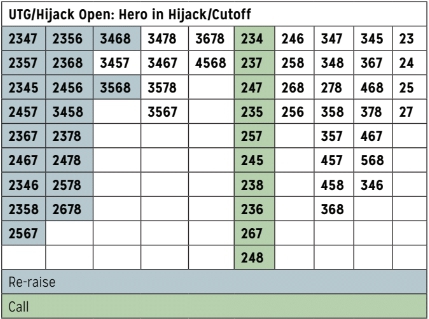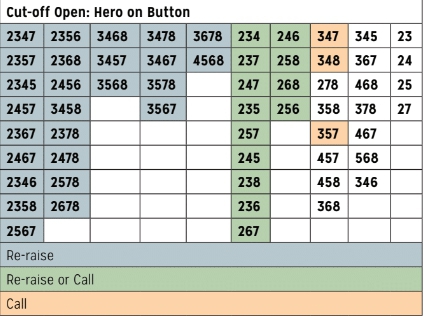






Deuce to Seven Triple Draw Lowball: Playing Against a Raiseby Kevin Haney | Published: Jun 17, 2020 |
|
|
As in all poker games, the decision on how to best proceed when someone opens the pot in front of you is a function of your opponent, their position at the table, your holding, and how many players are left to act.
Re-raising can allow you to possibly isolate yourself against a weaker hand and/or opponent, create dead money from blinds, and shut out skilled players who would have played for one more bet but not two. Cold-calling can prevent us from getting re-raised when our opponent is very strong and possibly entice weaker playing opponents to enter the pot with rough holdings that they probably should have folded. Folding is the best option when our hand is not strong and there are many players left to act or if we are out of position and will probably experience reverse implied odds.
While some of our decisions will ultimately be opponent-driven, we should have prepared defaults on how to proceed with any holding in any heads-up situation. There are not that many situations to consider, thus if you are serious about your game it is important to work through the various possibilities before encountering for the first time as the action is unfolding at the table. If we already know our default play down cold, we can spend a few seconds (we should play fast in limit) considering if we should deviate from it when taking into account the open-raiser and overall table dynamics.
With all of this in mind, let’s walk through a sample set of responses based upon a tight solid opener. The decisions on how to best proceed are based upon the general strength of the opening ranges per position, how often they may hold a deuce if we require one, and of course the potential of our holding.
Hero Is Outside The Blinds
Facing an open from one of the first two positions at a six-handed table, we need to play relatively snug as this range is often very strong. This would especially be the case if we are in either the hijack or the cutoff and thus have at least one player left to act behind and in general many opponents still remaining that could wake up with a premium holding.
UTG/Hijack Open: Hero in Hijack/Cutoff

With any pat eight or better low we should re-raise but should fold rough unbreakable nines such as 9-7-6-5-4 with so many players left to act. Premium and strong one-card draws (D1s) such as 2-3-5-7, 2-3-4-6, 2-3-6-8, and 3-5-6-8 should be re-raised as well.
It is also probably best to re-raise the 2-3-7-8 thru 2-6-7-8 holdings as the opener may be drawing two and we don’t want multiway action with these marginal one-card draws. However, with these hands we also have the option to draw two depending on how many opponents we end up against and how many cards they are drawing. For example, if we end up in a three-way pot and at least one player is drawing one it is probably best to draw two and try and build a stronger hand than an 8-7 low.
If you recall a previous column, a solid early position range has a relatively high percentage of pats and D1s (around 33 percent or more) and a deuce the majority of the time (approximately 90-95 percent) thus it is probably best to fold hands such as 3-4-5-7, 3-4-6-7, and 3-5-6-7. Keep in mind there are still many players to act who will not be folding premium two card draws (D2s) on the first betting round. And in this situation, we don’t want anything to do with very marginal draws such as 3-4-7-8 that do not contain a deuce.
We should just smooth call premium or very good D2 draws such as 2-3-7, 2-4-5, and 2-3-8 as there isn’t really much to be gained by re-raising these hands and possibly isolating ourselves against a very strong hand. Many players also choose to flat more mediocre holdings such as 2-4-6, 2-5-8, 2-6-8, and 2-5-6 and this is probably a small mistake.
While it’s true we have position on the raiser that will also most often be drawing two these hands are not that strong and there are still players left to act behind us. And it should be noted that other D2s listed as flats such as 2-3-6, 2-4-8, and even 2-6-7 are almost certainly equity underdogs against the range of most first position opens anyway. However, specifically when the opener is in the hijack and we are in the cutoff then flatting the slightly better hands such as 2-4-6 and 2-5-8 becomes more viable especially when holding a pair or two.
When Hero is on the button he can play somewhat more liberally against either an UTG or Hijack open.

Here we have added a few more holdings to the re-raising range (3-4-5-7, 3-4-7-8, 3-4-6-7, 3-5-7-8, and 3-5-6-7) and 2-4-6 and 2-5-8 to the flats. Our situation is more advantageous in that we are guaranteed last position and with a few folds in between we have a little more indication that the other deuces we need with the 3-4-5-7 and 3-4-7-8 type hands are live.
When an opponent opens from the cutoff their range is going to be significantly wider than that of the first two positions thus our default responses will be correspondingly looser as well:

Against the cutoff we should be playing and re-raising all of our D1s and possibly other holdings not listed on the chart such as 4-6-7-8 and 4-5-6-9 often turning them into a snow.
With our two card draws we can either re-raise or flat, however, we should tend to mostly be re-raising in this situation. Re-raising is best when some or all the following factors are present:
1. We have a premium D2 (2-3-4, 2-3-7, 2-4-7, 2-3-5, 2-5-7, and 2-4-5)
2. Villain is very loose
3. We have pairs
4. Blinds play very well
Flatting is more viable with our weaker D2s, when villain is on the tighter side, we have no blockers, and weak players are residing in the blinds.
3-4-7, 3-4-8, and 3-5-7 are somewhat marginal, however, we have position and given the lack of early position action it’s somewhat more likely the deuces are live which would give us a fantastic draw. The times we catch a deuce we are happy to have pulled weak players in the blinds into the pot with their potentially rough hands.
With our two-card draws we really shouldn’t be concerned about splitting our range between re-raises and flats as we aren’t giving our opponent any information that he will ultimately be able to use. When drawing two our final holding is far from defined as we don’t know what we will catch. When we re-raise with premium D2s we can end up patting 8-7 lows or nines and some of the hands we chose to flat such as 2-5-6 and 3-4-7 can make sevens. And sometimes we are flatting 2-3-4 and 2-3-7 because we don’t have any blockers and an action player is residing in the big blind.
Splitting our range is more precarious in a game such as Badugi where we are giving out a ton of useful information if we flat or re-raise three-card badugis based upon their strength. And as previously discussed we should not split our range in 27TD with one card draws as that is information our opponent can certainly use. However, with two-card draws we should just go ahead and play our holding in the manner that we feel will maximize expectation.
In the next installment on Deuce to Seven Triple Draw we will move on to the small blind which can be a very difficult position to play well. ♠
Kevin Haney is a former actuary of MetLife but left the corporate job to focus on his passions for poker and fitness. He is co-owner of Elite Fitness Club in Oceanport, NJ and is a certified personal trainer. With regards to poker he got his start way back in 2003 and particularly enjoys taking new players interested in mixed games under his wing and quickly making them proficient in all variants. If interested in learning more, playing mixed games online, or just saying hello he can be reached at haneyk612@gmail.com.
Features
The Inside Straight
Strategies & Analysis